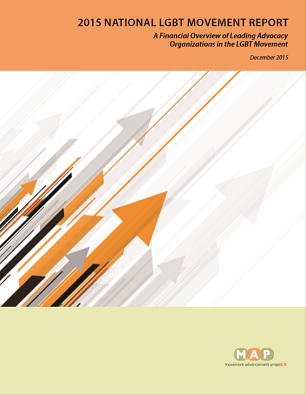The Bottom Line
The National LGBT Movement Report, published annually by MAP, examines revenue and expenses, fundraising and fundraising efficiency, and other indicators of financial health for lesbian, gay, bisexual and transgender (LGBT) social justice advocacy, issue, legal, research and public education organizations.
2015 National LGBT Movement ReportDownload 2014 National LGBT Movement ReportDownload 2013 National LGBT Movement ReportDownload 2012 National LGBT Movement ReportDownload 2011 National LGBT Movement ReportDownload 2010 National LGBT Movement ReportDownload
Abstract
The 2015 National LGBT Movement Report provides a comprehensive snapshot of the financial health of LGBT social justice advocacy organizations. The 38 organizations examined for the 2015 report collectively represent 66% of the budgets of all LGBT social justice advocacy organizations. Among the key findings in the 2015 report:
Revenue and Expenses. LGBT social justice organizations’ revenues experienced a decline in revenue for the first time since the Great Recession of 2007-2008. Organizations are projecting combined 2015 expense budgets totaling $189.6 million, a 12% increase from 2014 expenses. While individual donor revenue grew 11% from 2013 to 2014, organizations lost an aggregate of $6.3 million of revenue from foundations over the same period, an 18% drop. Half of participating organizations experienced revenue declines, with the average of these organizations experiencing a shocking 20% revenue decline. Comparing participating LGBT organizations to national averages outside of the LGBT movement, revenue for the top 100 nonprofit organizations across the country increased 3.4%, compared to the 0.4% decrease in revenue for LGBT organizations.
Fundraising and Fundraising Efficiency. Fundraising and individual donations continue to increase, with a notable spike in individual giving, which increased 11% from 2013 to 2014 for participating LGBT nonprofits, compared to a 5.7% increase in individual giving for nonprofits nationwide. Movement groups are highly efficient in their fundraising and programming operations. On average, 81% of total expenses are dedicated to programs and services —exceeding benchmarks of the American Institute of Philanthropy and Better Business Bureau Wise Giving Alliance.
Other Indicators of Financial Health. General financial health remains strong. In 2014, organizations reported an average of nearly six months of available working capital, a 2% increase from 2013.
Staff and Boards. The racial and ethnic diversity of paid staff at participating organizations have similar diversity to the overall population: 38% of paid staff identify as people of color compared to 38% of the U.S. population. However, among senior staff, the percentage who are people of color was 35%. Also, 46% of all staff are women and 8% identify as transgender.
2015 Participating Organizations
ACLU LGBT & AIDS Project
Basic Rights Oregon
CenterLink
Empire State Pride Agenda
Equality California
Equality Federation
Equality Florida
Equality Maine
Family Equality Council
Freedom to Marry
Funders for LGBTQ Issues
Gay & Lesbian Advocates & Defenders (GLAD)
Gay & Lesbian Victory Fund and
Leadership Institute
Gay, Lesbian and Straight Education Network (GLSEN)
Gay-Straight Alliance Network
GLAAD
Human Rights Campaign and Foundation (HRC)
Immigration Equality
Keshet
Lambda Legal
Log Cabin Republicans
MassEquality
National Black Justice Coalition
National Center for Lesbian Rights (NCLR)
National Center for Transgender Equality (NCTE)
National Queer Asian Pacific Islander Alliance (NQAPIA)
New York City Gay and Lesbian Anti-Violence Project
Out & Equal Workplace Advocates
PFLAG National
Point Foundation
Reconciling Ministries Network
Services & Advocacy for GLBT Elders (SAGE)
Soulforce
Sylvia Rivera Law Project
The National LGBTQ Task Force
Transgender Law Center
The Trevor Project
(One organization preferred not to be listed.)


